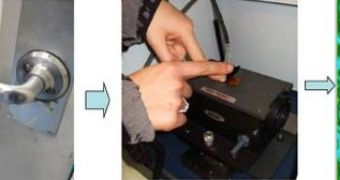A perfect crime is a utopia. And it's getting even more than this, as a new fingerprinting technique can reveal surprising details about the criminal.
Standard methods of fingerprinting at a crime scene include the use of powders, liquids or vapors, but they can alter the prints and destroy precious clues, like chemicals traces. The new technique involving a tape made from gelatin makes possible a chemical analysis of the prints gathered at crime scenes, revealing specific information about miscreants' diets and whether they smoke or not and possibly their sex and race.
"The gel tape can gather prints from a variety of surfaces, including door handles, mug handles, curved glass and computer screens, just as conventional fingerprint techniques can. The gelatin is then irradiated with infrared rays inside a highly sensitive instrument that rapidly takes a kind of "chemical photograph," identifying molecules within the print in 30 seconds or less," said physical chemist Sergei Kazarian at Imperial College London.
A fingerprint is made of few millionths of a gram of fluid, about the same material quantity like in a grain of sand. "That might, however, be enough to determine valuable clues about a person beyond the print itself, such as their gender, race, diet and lifestyle", said Kazarian.
For example, males are detected based on the greater amounts of urea (a main chemical of the urine) in their fingerprints, as they sweat more urea than women. Chemical mix within prints is also linked to the age and race of people and keeps traces of items manipulated by people, like gunpowder, smoke, drugs, explosives, or biological or chemical weapons. "Even a person's diet might be determined from fingerprints, as vegetarians may have different amino acid content than others. More volunteers need to be tested for statistical information on fingerprints with regard to race, sex and so on, but we believe this will be a powerful tool," Kazarian told LiveScience.
"In addition, unlike conventional fingerprint techniques, the new method did not distort or destroy the original prints, instead keeping them intact and available for further analysis," the researchers said.
Other techniques can detect chemicals in fingerprints by employing X-rays, but this one is extremely rapid.

 14 DAY TRIAL //
14 DAY TRIAL //